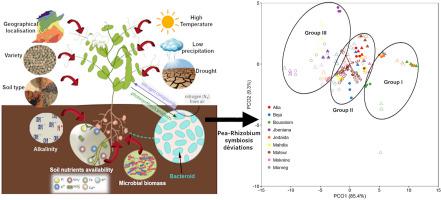Rhizosphere ( IF 3.4 ) Pub Date : 2020-12-20 , DOI: 10.1016/j.rhisph.2020.100304 Amira Hachana , Imen Hemissi , Amir Souissi , Boulbaba L'Taief , Neila Abdi , Manel Bouraoui , Rahmah N. Al-Qthanin , Hanen Arfaoui , Bouaziz Sifi

|
Pedological constrains and varietal recommendations are serious causes of Pea-Rhizobium symbiosis efficiency deviations in Tunisia limiting pea crop adaptation to varying environments. In order to explore variation patterns of this symbiosis in contrasting soils and varieties and appreciate its contribution to plant adaptation, nine locations with potential pea crop vocation are prospected for collection of soils. Two pea varieties with different cycle length are randomly sown on triplicate irrigated containers and placed on natural condition during two seasons. The results have shown that soil fertility is mostly low and highly variable. It is mainly affected by high active limestone content and pH or by salinity. The studied factors (Soil type, Variety) have presented highly significant effect on native rhizobia efficiency, pea root nodulation, shoot and root biomass production, and shoot nitrogen accumulation (p < 0.0001). The long cycle variety gave the highest nodulation and adaptability to pedological variations. The multivariate data analysis indicates that Pea-Rhizobium symbiosis efficiency variability is mainly due to soil microbial biomass, phosphorus, organic matter, and electrical conductivity differences between soils. However, Principal Coordinate Analysis has confirmed the determining effect of these variables on rhizobia effectiveness, pea nodulation, growth and nitrogen accumulation. These results confirm that nitrogen-fixing symbiosis does not contribute in adaptation of pea crop to pedological constrains in Tunisia. Rhizobial inoculation and sepecific fertilization managment have become an urgent need to improve the production of this crop.
中文翻译:

突尼斯豌豆-根瘤菌共生效率对病因和品种变异的响应
教育上的限制和推荐品种是豌豆根瘤菌的严重原因突尼斯的共生效率偏差限制了豌豆作物适应不同环境的能力。为了探索这种共生在不同土壤和品种中的变化模式,并了解其对植物适应的贡献,我们对九个具有潜在豌豆农作物习性的地点进行了土壤收集。将两种具有不同周期长度的豌豆品种随机播种在一式三份的灌溉容器中,并在两个季节中置于自然条件下。结果表明,土壤肥力大多较低且变化很大。它主要受高活性石灰石含量和pH值或盐度的影响。研究的因素(土壤类型,品种)对天然根瘤菌效率,豌豆根结瘤,枝条和根系生物量生产以及枝条氮积累表现出极显着的影响(p <0.0001)。长周期的变种对根瘤学变异具有最高的结瘤和适应性。多元数据分析表明,豌豆根瘤菌共生效率差异主要是由于土壤微生物量,磷,有机质和土壤之间的电导率差异。但是,主坐标分析已经确认了这些变量对根瘤菌效力,豌豆结瘤,生长和氮积累的决定性影响。这些结果证实固氮共生在突尼斯的豌豆农作物适应于生态学约束方面没有贡献。根瘤菌接种和专门的施肥管理已成为提高该作物产量的迫切需求。











































 京公网安备 11010802027423号
京公网安备 11010802027423号